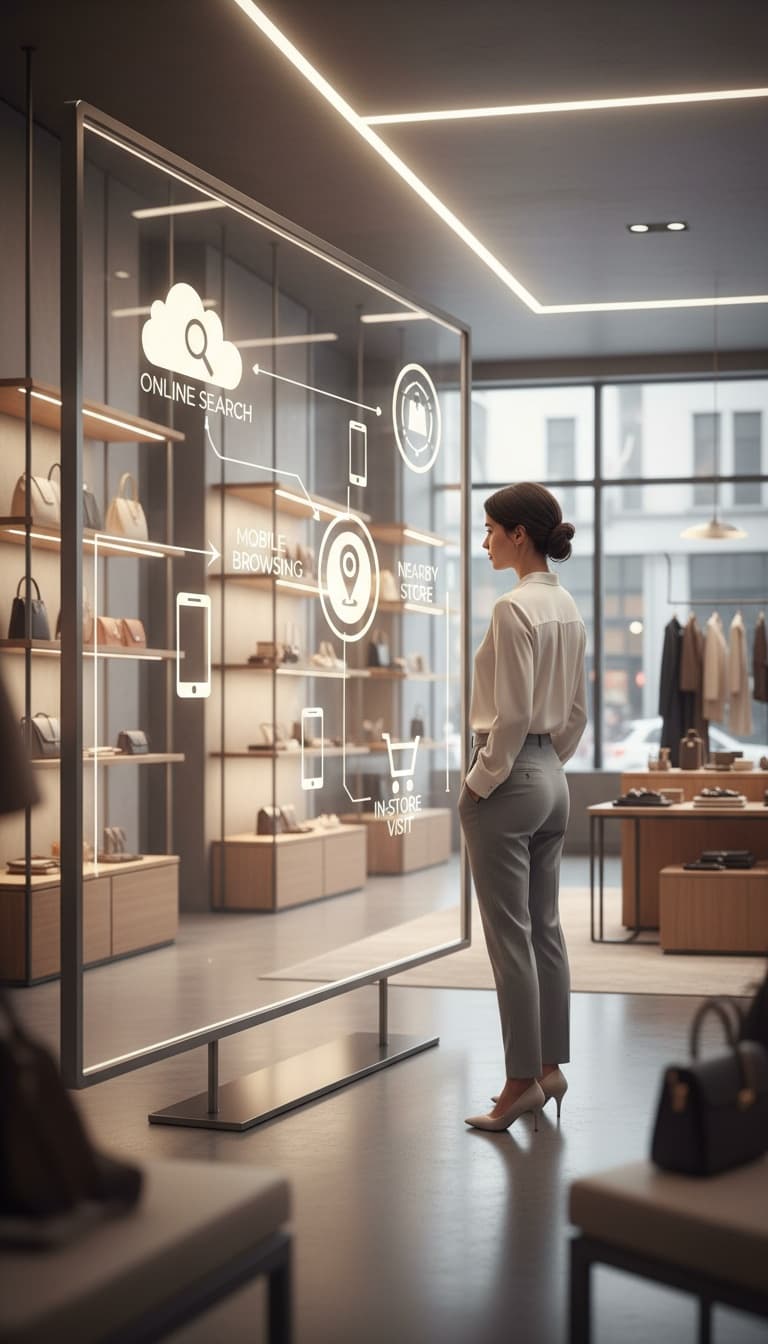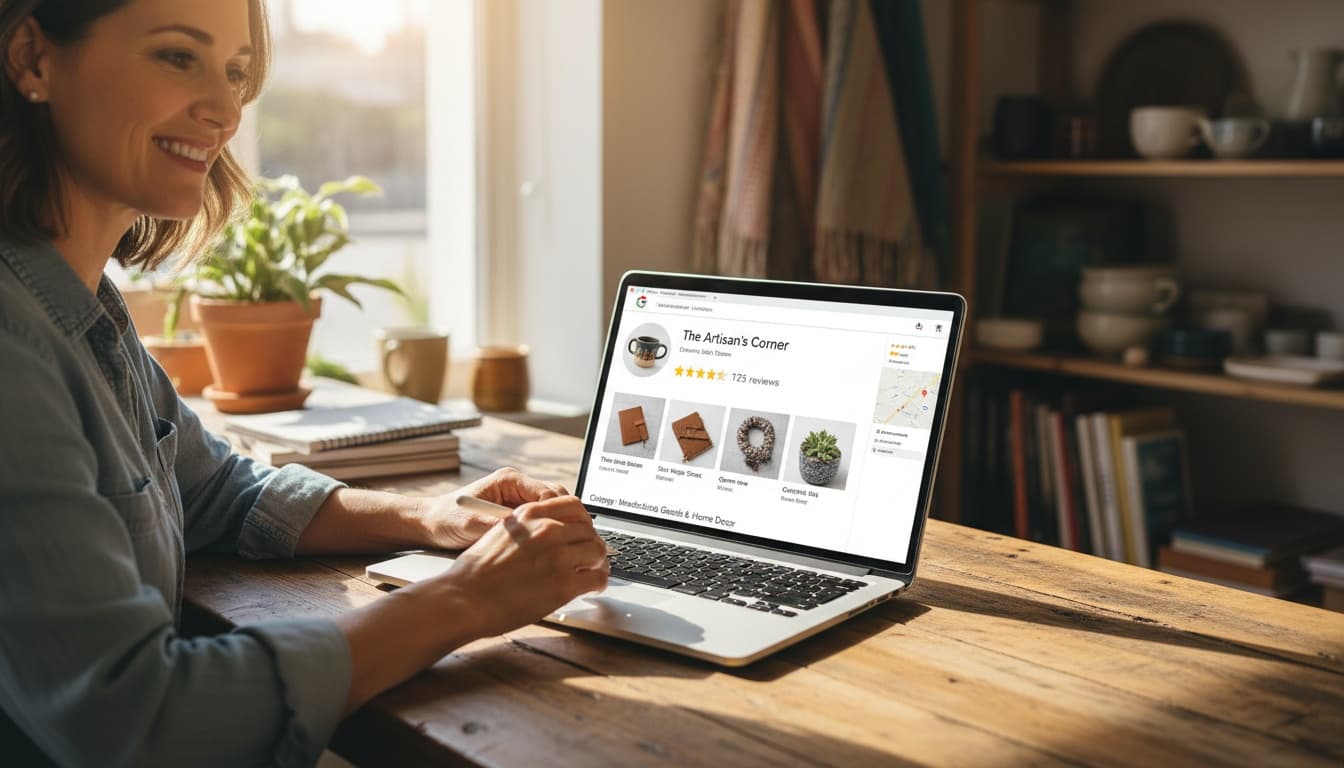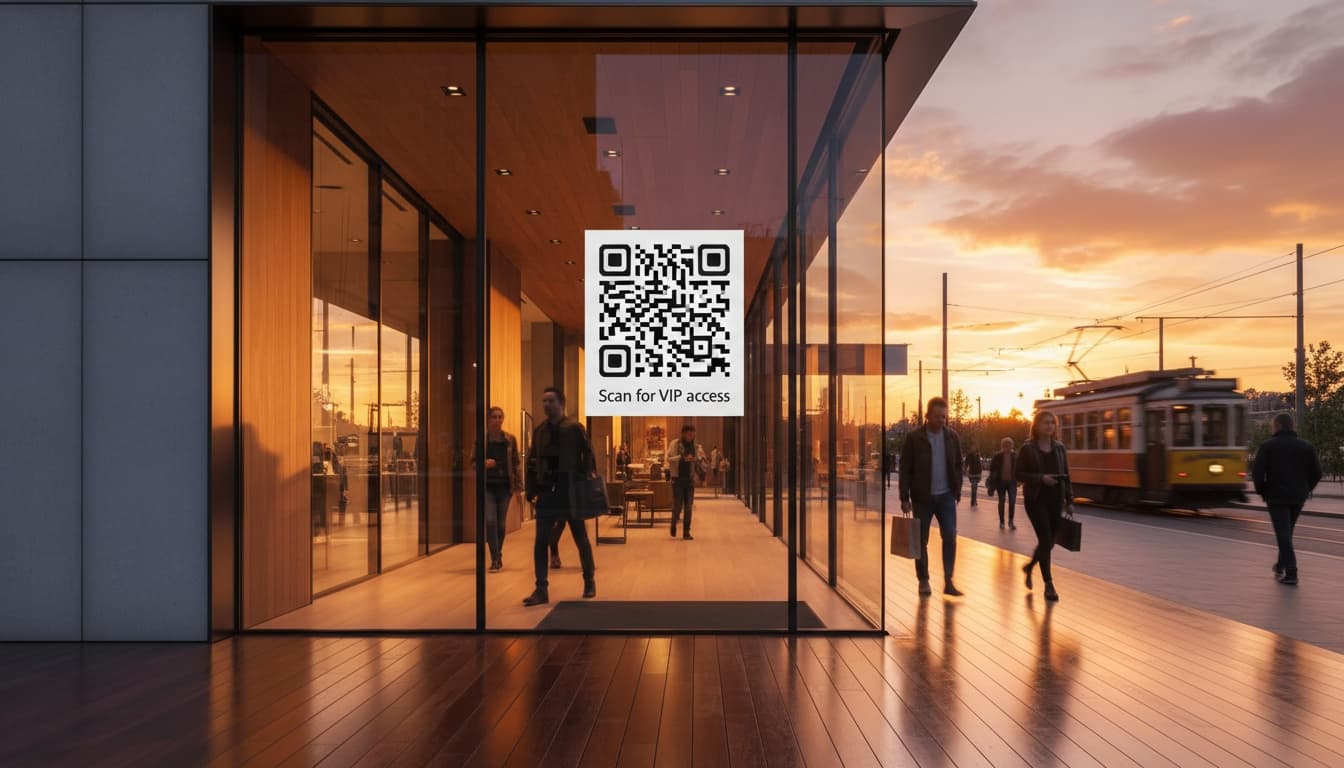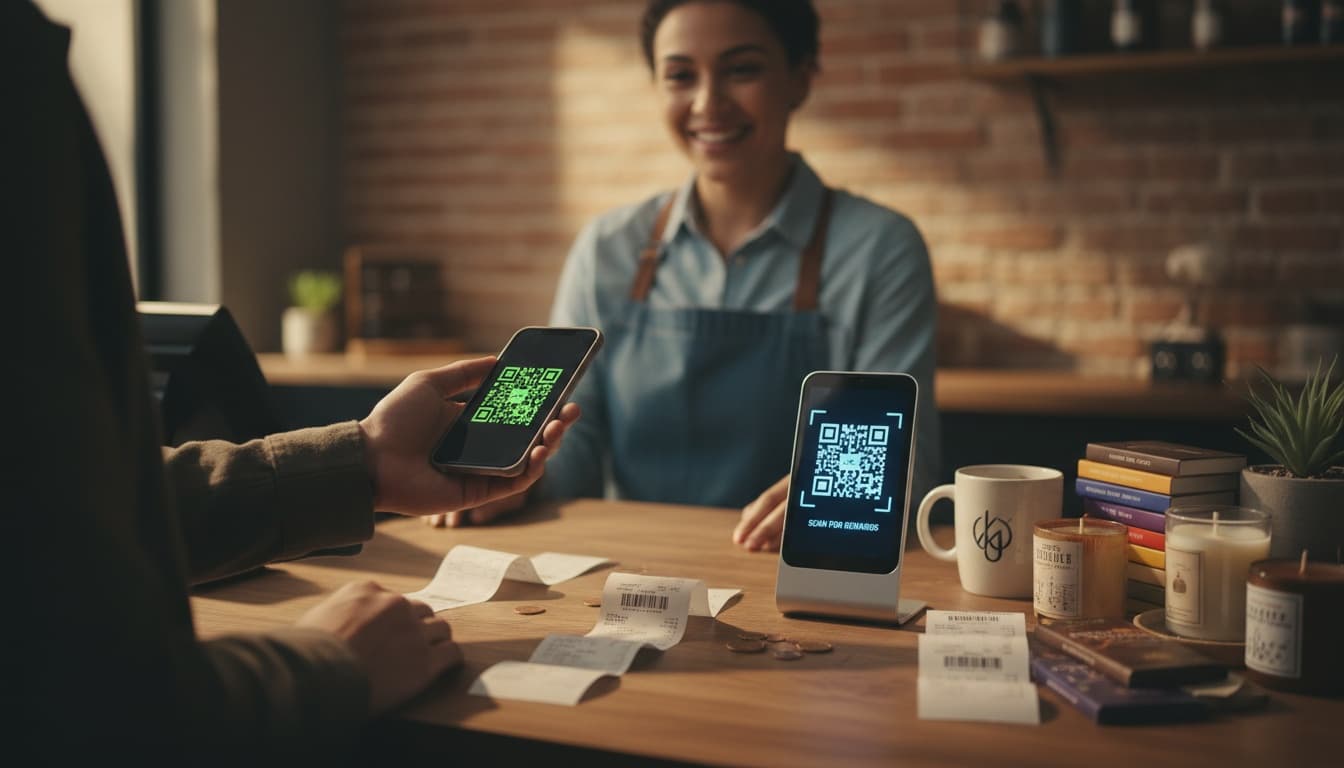The retail landscape in 2025 is shaped by hybrid shopping journeys where customers move fluidly between online research and in-store visits. While average foot traffic has declined in many categories, the most successful retailers are converting their stores into experience-driven destinations that people actively choose to visit. Winning more visits now depends on how well you integrate digital discovery, in-store experience, and continuous optimization based on data.
This guide explains how to increase foot traffic to your retail store using a structured approach: understanding modern shopper psychology, building a strong digital foundation, using QR codes to bridge digital and physical experiences, implementing interactive displays, designing loyalty programs that drive visits, activating events and partnerships, and measuring results with clear metrics and attribution.
Understand Modern Retail Shopper Behavior

Most in-store journeys now begin online. Consumers search for nearby options, compare prices, read reviews, and check availability before deciding whether it is worth visiting in person. When you understand this behavior, foot traffic becomes a predictable output of how well your digital and physical touchpoints work together.
Three forces shape modern shopper decisions:
- Digital-first discovery - people search maps, social media, and marketplaces before stepping out.
- Experience expectations - customers want more than shelves, they want guidance, inspiration, and convenience.
- Social proof and validation - reviews, user content, and visible popularity strongly influence visit intent.
Your goal is to remove friction at each decision point. When a shopper searches nearby, they should find clear information, see strong reviews, understand why your store is different, and feel confident that visiting will be worth their time.
Build a Digital Foundation That Sends People to Your Store

Before you invest in campaigns or events, make sure your digital foundation is solid. For most customers, your Google Business Profile and local SEO are the primary drivers of intent to visit.
Optimize Your Google Business Profile
A fully optimized profile can significantly increase direction requests and visits. Make sure you:
- Claim and verify your listing with accurate name, address, phone, website, and business category.
- Keep opening hours, special schedules, and holiday exceptions up to date.
- Upload high quality photos of the storefront, interior, staff, and best selling products.
- Use weekly posts to highlight new arrivals, promotions, or in-store events.
- Respond to all reviews, positive and negative, within a reasonable timeframe.
- Answer common questions about parking, accessibility, payment methods, and returns.
Strengthen Local SEO
Your website should reinforce what customers see on your profile. Focus on:
- Location-specific landing pages that include city, neighborhood, and category keywords.
- Consistent NAP data across directories and social media profiles.
- Fast mobile performance so people can load your site on the street without delays.
- Clear directions, embedded maps, and parking information on your contact page.
Use Social Media as a Foot Traffic Engine
Social platforms are not just for brand awareness. When you connect content with reasons to visit now, they become direct traffic drivers.
- Show real customers using your products and tag your location on every post.
- Share time-sensitive reasons to visit such as new drops, limited offers, or in-store demos.
- Use Stories and short videos to show what is happening in the store today.
- Add clear call to actions to visit in person for exclusive benefits or experiences.
Use QR Codes to Connect Digital Attention With Store Visits

QR codes are one of the simplest tools to bridge digital and physical interactions. When used strategically, they turn passive interest into trackable intent and visits.
High Impact QR Code Placements
- Storefront windows inviting people to scan for exclusive in-store rewards, early access, or appointment slots.
- Outdoor signage and flyers that capture attention before someone decides which store to enter.
- Product displays that link to styling ideas, tutorials, or bundles only available in-store.
- Receipts and packaging that send customers back for a next visit voucher or scan-to-win mechanic.
Best Practices for QR Experiences
- Use dynamic QR codes so you can update campaigns without reprinting materials.
- Ensure landing pages load quickly, are mobile-first, and show value immediately.
- Use clear copy such as scan to unlock your in-store reward or scan to reserve in-store pickup.
- Track scans with UTM parameters and tie them to store visit metrics where possible.
Platforms like VISU allow you to run gamified scan campaigns, reward repeat visits, and share value between brands, customers, and local partners while keeping all data and performance in one place.
Turn Your Store Into an Experience, Not Just a Shelf

Once your digital front door is working, the next lever for foot traffic is experience design. When people have a memorable visit, they return more often and talk about your store to others.
Design for Discovery and Comfort
- Create clear sightlines so visitors understand what you sell within a few seconds.
- Use focal displays that highlight new or curated items at the front of the store.
- Provide comfortable zones where people can take time to evaluate products.
- Use music, scent, and lighting to create a recognizable atmosphere.
Integrate Interactive and Digital Elements
Interactive features give customers a reason to stay longer and explore new areas of the store.
- Install simple tablets or screens that show product stories or styling recommendations.
- Use QR codes on shelves to reveal extra content or unlock small rewards.
- Create designated photo spots where customers can share their visit on social media.
- Offer guided discovery paths such as new in, staff picks, or under a certain price.
The goal is not to add technology for its own sake but to remove uncertainty and make exploring more rewarding. Every interactive element should either help customers choose, feel more confident, or have more fun in the store.
Build Loyalty and Rewards That Pull Customers Back In

Loyalty systems that only collect points on spend often fail to change behavior. To drive foot traffic, your program should reward visits and engagement, not just transactions.
Design a Visit-Centric Loyalty Program
- Reward frequency of visits and specific actions such as attending events or scanning in store.
- Offer small instant rewards to create the habit and larger experiential rewards to create emotion.
- Use tiered levels that unlock benefits like early access, private previews, or special appointments.
- Communicate clearly what people need to do next to reach the next reward or level.
Use QR-based check-ins at the door or at the counter so customers can identify themselves quickly without friction. A platform that connects scans, visits, and rewards in one place makes it much easier to run campaigns and measure impact.
Use Events and Partnerships to Generate Surges of Foot Traffic

Events and collaborations give customers a concrete reason to visit on specific dates instead of delaying a trip indefinitely.
Plan Strategic Event Types
- Launch events for new collections or product collaborations.
- Workshops that teach a practical skill connected to your category.
- Exclusive preview nights for loyalty members or top customers.
- Seasonal experiences aligned with holidays or local festivals.
Each event should have a clear objective such as driving first visits from new segments, reactivating lapsed customers, or increasing basket size among regulars.
Activate Local Partnerships
Partnerships with nearby businesses, creators, or community organizations can multiply your reach.
- Co-host events where each partner invites their own audience.
- Create scan-to-unlock trails across multiple locations with shared rewards.
- Offer cross-store benefits such as show your receipt from partner X to unlock Y.
Use shared QR campaigns to track which partnerships drive the most visits and refine your network over time.
Measure What Really Drives Foot Traffic
Increasing visits is only sustainable if you measure cause and effect. Combine physical and digital metrics in a simple dashboard so you can see what is working and where you should invest.
Key Metrics to Track Weekly
- Daily visitor counts and conversion rate to purchases.
- Average visit duration and areas where people spend most time.
- New versus returning visitors and visit frequency for loyalty members.
- Scans, redemptions, and visit attribution from QR campaigns.
- Direction requests, website clicks, and calls from your Google profile.
Translate these into simple impact calculations. For example, if a new campaign brings 20 extra visitors per day and 30 percent convert at an average transaction value of 30 dollars, that is 180 dollars in extra daily revenue. Over a month, those incremental gains compound.
The most effective retailers treat foot traffic as a system, not a mystery. They test small changes in messages, placements, and experiences, then double down on what moves the numbers in a measurable way.
30 Day Action Plan to Increase Foot Traffic
To turn this guide into execution, follow a simple four week roadmap and adapt it to your store size and category.
Week 1 - Fix the Digital Front Door
- Update and fully complete your Google Business Profile.
- Refresh store photos and ensure hours and contact data are accurate.
- Audit your website for local SEO basics and mobile clarity.
- Set up simple tracking for daily visitor counts.
Week 2 - Deploy QR and Basic Loyalty
- Create dynamic QR codes for storefront, key displays, and receipts.
- Design a simple visit-based reward such as every third visit unlocks a benefit.
- Connect QR scans to a platform that tracks engagement and visits.
- Launch one clear call to action such as scan to unlock your in-store welcome reward.
Week 3 - Enhance the In-Store Experience
- Rework entrance and front displays to emphasize discovery and clarity.
- Add at least one interactive element such as a styling corner or product story station.
- Train staff on how to invite customers to scan, join the program, or attend events.
- Plan one small in-store activation for the coming week.
Week 4 - Run an Event and Analyze Results
- Host your first focused event or collaboration with a clear attendance goal.
- Promote the event across social, email, and your Google profile posts.
- Use QR-based check-in to track attendees and link them to visits.
- Review the full month, compare traffic before and after, and choose two actions to scale.
By the end of 30 days, you should see clearer patterns between digital signals, QR interactions, and in-store visits. From there, you can refine your offers, content, and partnerships to build a repeatable traffic engine rather than relying on one-off promotions or discounts.
Turn Local Attention Into Measurable Retail Visits
VISU helps retailers connect QR scans, digital campaigns, and in-store rewards in a single platform so you can see exactly what brings people through the door. Create gamified campaigns, reward visits, and share value with partners without building your own infrastructure.

